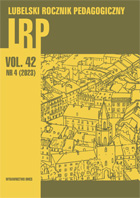EDUCATIONAL SPACE IN INCLUSIVE EDUCATION –
CHALLENGES IN WORKING WITH A DIVERSE
GROUP/CLASS
EDUCATIONAL SPACE IN INCLUSIVE EDUCATION –
CHALLENGES IN WORKING WITH A DIVERSE
GROUP/CLASS
Author(s): IWONA CHRZANOWSKASubject(s): School education, Inclusive Education / Inclusion, Pedagogy
Published by: Wydawnictwo Naukowe Uniwersytetu Marii Curie-Sklodowskiej
Keywords: school educational space; diverse class;
Summary/Abstract: Introduction: Nowadays, teachers must be aware that the student population in school classesis becoming increasingly diverse. Therefore, it is necessary to design educational spaces thatnot only cater to the diverse needsof students but also align with the requirements of the 21stcentury.Research Aim: This research seeks to investigate the importance of educational spaces whenworking with a diverse group or class in inclusive education. The research question focuses onunderstanding how to design, why to change educational spaces in education.Evidence-based Facts: The educational environment can play the role of the “third teacher”and either support or hinder the development of students. Engaging educational environmentsare crucial for the cognitive, physical, social, and emotional development of students. Theypromote critical thinking, communication, collaboration, and creativity, all of which are consi-dered essential competencies in 21st-century education.Summary: Diverse student needs require diverse learning spaces to meet the requirementsand address the needs of every student. These spaces are often described using metaphors likea watering hole, cave, campfire, or laboratory. Students should be involved in the creation ofeducational spaces. However, students’ perspectives are frequently overlooked. Research findin-gs indicate that considering their input enhances the likelihood of providing better and moreeffective support for their development. In traditional education, teachers play a central rolein selecting teaching methods and determining modes of school communication. There arealready examples of how to transform a school’s environment to make it inclusive for everyone.
Journal: Lubelski Rocznik Pedagogiczny
- Issue Year: 42/2023
- Issue No: 4
- Page Range: 59-75
- Page Count: 17
- Language: English

